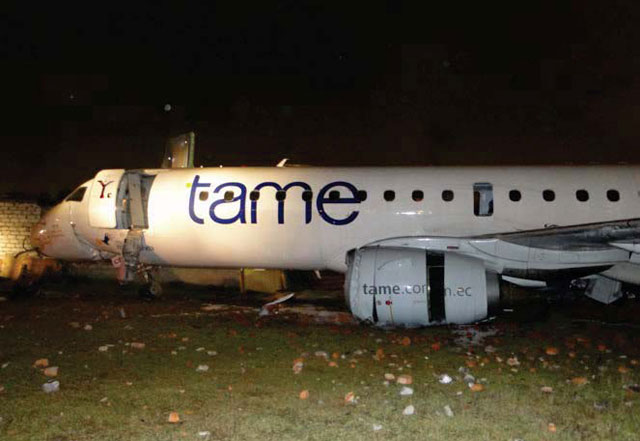Ecuadorian investigators have determined that the crew of a TAME Embraer 190 did not follow correct procedures for flap failure before landing at Quito and overrunning the runway.
As the aircraft descended towards runway 35, after arriving from Loja, its centralised monitoring system alerted the crew to a flap and slat problem.
Ecuador's Junta Investigadora de Accidentes says the pilots attempted five times to reset the flaps, but that the slats would not deploy and the flaps would only move to position 2.
The crew, however, decided to continue the approach with the high-lift surfaces in these positions, "without carrying out" the appropriate Embraer procedure in the quick-reference handbook, says the JIA.
 |
|---|
 |
JIA analysis calculated the aircraft's reference speed for this configuration at 149kt, and put the actual landing distance at 1,950m. The 3,120m runway was wet with average braking action.
But the aircraft was still travelling at 164kt while 50ft above the ground, and 80m before the threshold. Although the pilots had intended to land close to the threshold, to provide maximum distance for stopping, the aircraft floated and did not make runway contact until 880m beyond.
After touchdown the aircraft travelled for 70m before the spoilers deployed, another 330m before the thrust-reversers activated, and a further 380m before braking started. Full braking was not applied until 2,300m past the threshold.
The aircraft, which was transporting 97 passengers and six crew, failed to stop in the available distance.
After overrunning, the 190 crashed through six instrument landing system antenna structures before striking a perimeter wall and coming to rest 300m from the runway end.
It suffered severe damage, mainly to its undercarriage and the underside of its fuselage, as well as to the leading edges of its wings.
Investigators discovered that maintenance records for the aircraft showed 53 occurrences of slat-flap failure messages in the two months preceding the 17 September 2011 accident. The inquiry questioned whether corrective measures were being properly applied and has recommended that the operator puts more robust analytical processes in place.
But it primarily attributes the accident to the crew's failure to follow the correct procedures for dealing with the flap problem. The JIA adds that the crew "did not respect" sterile cockpit requirements and that this was detrimental to their concentration.
Source: Air Transport Intelligence news



















